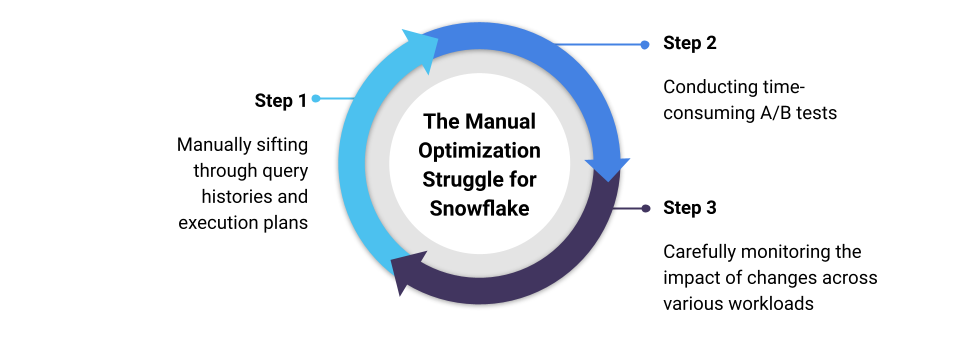The Complexities of Code Optimization in Snowflake: Problems, Challenges, and Solutions
In the world of Snowflake data warehousing, code optimization is crucial for managing costs and ensuring efficient resource utilization. However, this process is fraught with challenges that can leave even experienced data teams scratching their heads.
This blog post explores the complexities of code optimization in Snowflake, the difficulties in diagnosing and resolving issues, and how automated solutions can simplify this process.
The Snowflake Code Optimization Puzzle

1. Inefficient JOIN Operations
Problem: Large table joins often lead to excessive data shuffling and prolonged query times, significantly increasing credit consumption.
Diagnosis Challenge: Pinpointing the exact cause of a slow JOIN is like finding a needle in a haystack. Is it due to poor join conditions, lack of proper clustering, or simply the volume of data involved? The query plan might show a large data shuffle, but understanding why it’s happening and how to fix it requires deep expertise and time-consuming investigation.
Resolution Difficulty: Optimizing JOINs often involves a trial-and-error process. You might need to experiment with different join types, adjust clustering keys, or even consider restructuring your data model. Each change requires careful testing to ensure it doesn’t negatively impact other queries or downstream processes.
2. Suboptimal Data Clustering
Problem: Poor choices in clustering keys lead to inefficient data access patterns, increasing query times and, consequently, costs.
Diagnosis Challenge: The effects of suboptimal clustering are often subtle and vary depending on query patterns. A clustering key that works well for one set of queries might be terrible for another. Identifying the root cause requires analyzing a wide range of queries over time, a task that’s both time-consuming and complex.
Resolution Difficulty: Changing clustering keys is not a trivial operation. It requires careful planning, as it can temporarily increase storage costs and impact query performance during the re-clustering process. Determining the optimal clustering strategy often requires extensive A/B testing and monitoring.
3. Inefficient Use of UDFs
Problem: While powerful, User-Defined Functions (UDFs) can lead to unexpected performance issues and increased credit consumption if not used correctly.
Diagnosis Challenge: UDFs are often black boxes from a performance perspective. Traditional query profiling tools might show that a UDF is slow, but they can’t peer inside to identify why. This opacity makes it extremely difficult to pinpoint the root cause of UDF-related performance issues.
Resolution Difficulty: Optimizing UDFs often requires rewriting them from scratch, which can be time-consuming and risky. You might need to balance between UDF performance and maintainability, and in some cases, completely rethink your approach to the problem the UDF was solving.
4. Complex, Monolithic Queries
Problem: Large, complex queries can be incredibly difficult to optimize and may not leverage Snowflake’s MPP architecture effectively, leading to increased execution times and costs.
Diagnosis Challenge: Understanding the performance characteristics of a complex query is like solving a multidimensional puzzle. Each part of the query interacts with others in ways that can be hard to predict. Traditional query planners may struggle to provide useful insights for such queries.
Resolution Difficulty: Optimizing complex queries often requires breaking them down into smaller, more manageable parts. This process can be incredibly time-consuming and may require significant refactoring of not just the query, but also the surrounding ETL processes and downstream dependencies.
The Manual Optimization Struggle
Traditionally, addressing these challenges involves a cycle of:

1. Manually sifting through query histories and execution plans
2. Conducting time-consuming A/B tests
3. Carefully monitoring the impact of changes across various workloads
4. Rinse and repeat
This process is not only time-consuming but also prone to human error. It requires deep expertise in Snowflake’s architecture, SQL optimization techniques, and your specific data model. Even then, optimizations that work today might become inefficient as your data volumes and query patterns evolve.
The Power of Automation in Snowflake Optimization
Given the complexities and ongoing nature of these challenges, many organizations are turning to automated solutions to simplify and streamline their Snowflake optimization efforts. Tools like Unravel can help by:
Continuous Monitoring: Automatically tracking query performance, resource utilization, and cost metrics across your entire Snowflake environment.
Intelligent Analysis: Using machine learning algorithms to identify patterns and anomalies that might be missed by manual analysis.
Root Cause Identification: Quickly pinpointing the source of performance issues, whether they’re related to query structure, data distribution, or resource allocation.
Optimization Recommendations: Providing actionable suggestions for query rewrites, clustering key changes, and resource allocation adjustments.
Impact Prediction: Estimating the potential performance and cost impacts of suggested changes before you implement them.
Automated Tuning: In some cases, automatically applying optimizations based on predefined rules and thresholds.
By leveraging such automated solutions, data teams can focus their expertise on higher-value tasks while ensuring their Snowflake environment remains optimized and cost-effective. Instead of spending hours digging through query plans and execution logs, teams can quickly identify and resolve issues, or even prevent them from occurring in the first place.
Conclusion
Code optimization in Snowflake is a complex, ongoing challenge that requires continuous attention and expertise. While the problems are multifaceted and the manual diagnosis and resolution process can be daunting, automated solutions offer a path to simplify and streamline these efforts. By leveraging such tools, organizations can more effectively manage their Snowflake costs, improve query performance, and allow their data teams to focus on delivering value rather than constantly fighting optimization battles.
Remember, whether you’re using manual methods or automated tools, optimization is an ongoing process. As your data volumes grow and query patterns evolve, staying on top of performance and cost management will ensure that your Snowflake implementation continues to deliver the insights your business needs, efficiently and cost-effectively.
To learn more about how Unravel can help optimize your code in Snowflake, request a health check report, view a self-guided product tour, or request a demo.


